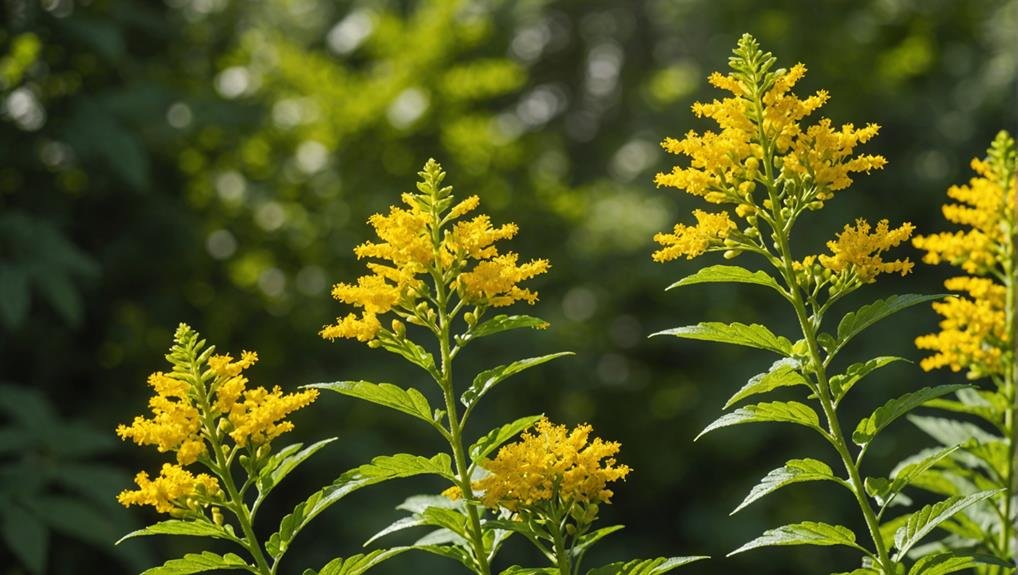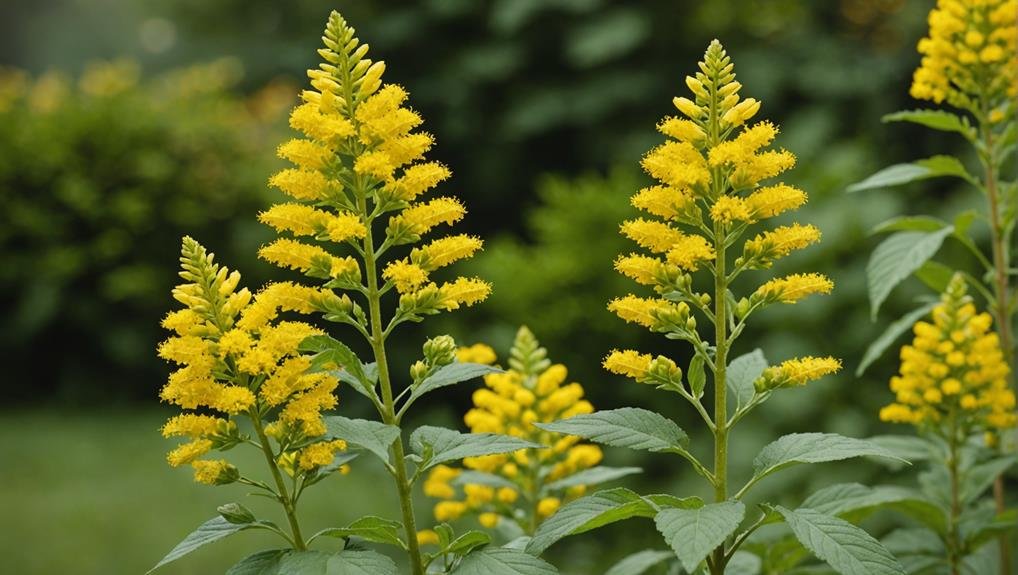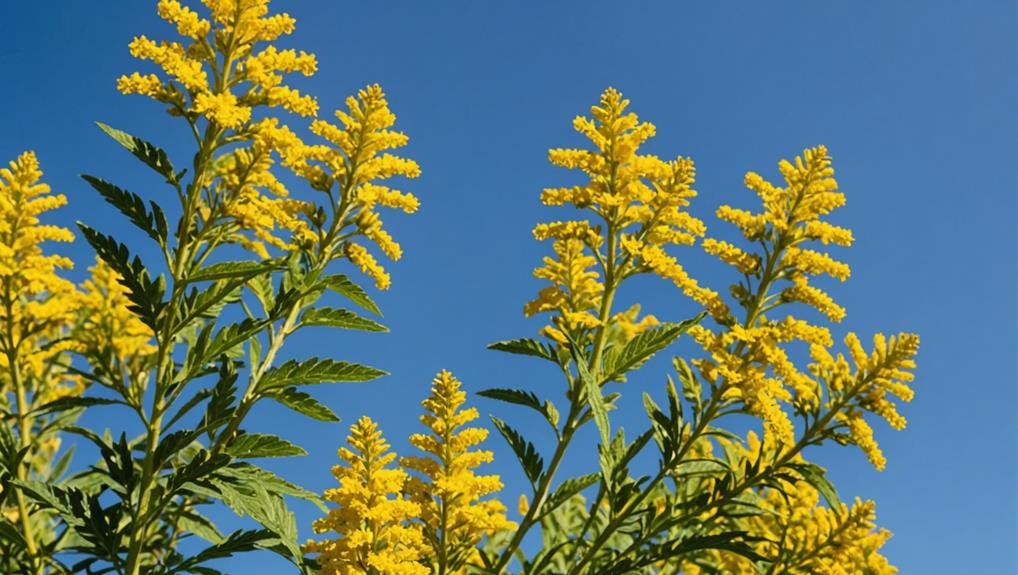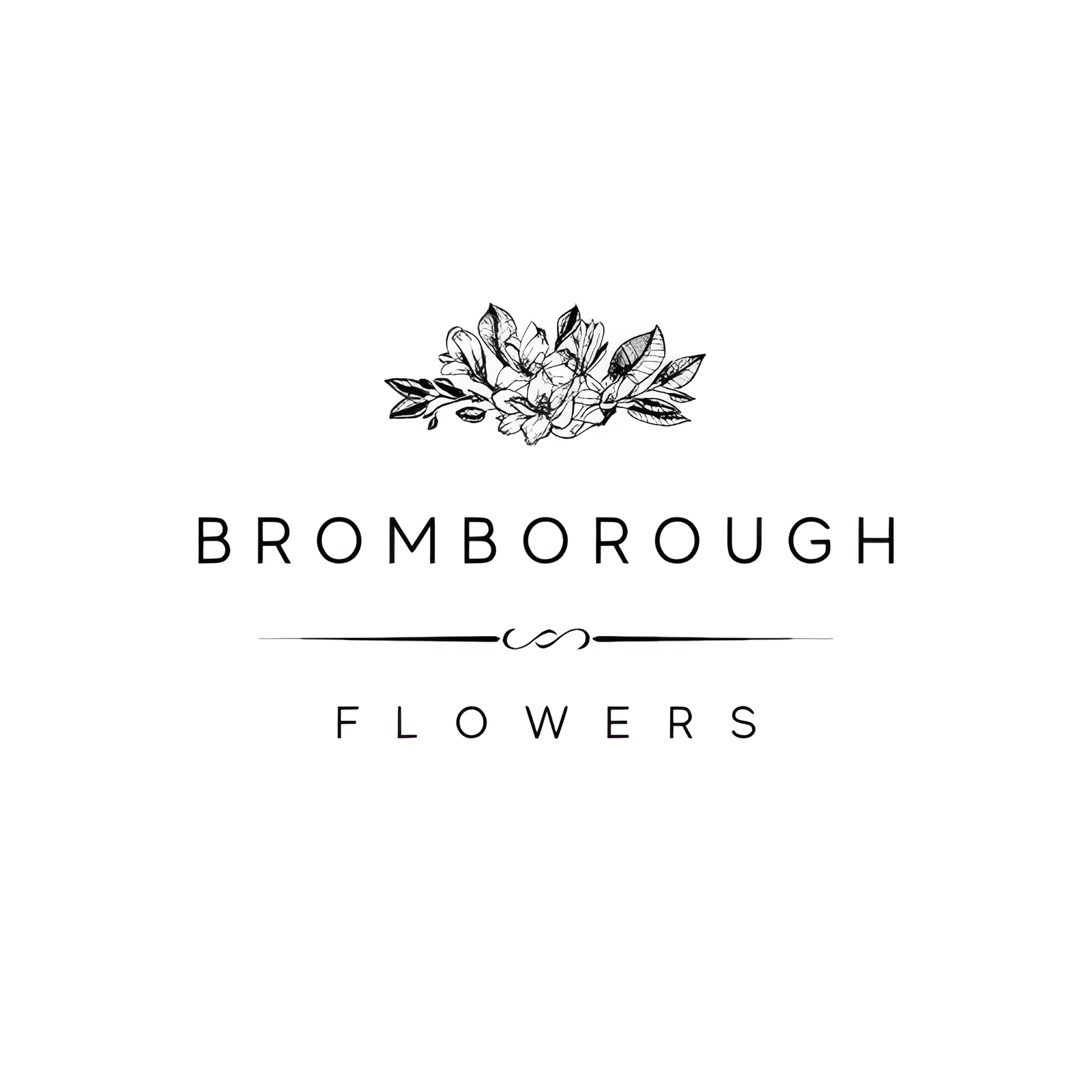Goldenrod, scientifically known as Solidago, presents itself as an exceptional choice for wedding floral arrangements, offering both aesthetic appeal and cost efficiency. Characterized by its vibrant yellow hue and clustered blooms, this versatile flower is available throughout the year, making it a reliable option regardless of the season. Its symbolic meanings of good fortune, prosperity, and protection further enhance its desirability for matrimonial celebrations. In our guide, we will explore the myriad ways Goldenrod can be integrated into wedding decor, from bouquets to standalone displays, and why it stands out among other floral options.
Flower Overview

Goldenrod, scientifically identified as Solidago, is a favored filler flower acknowledged for its multi-bloom tiny clusters on each stem. This flower is a popular choice for DIY wedding flowers due to its versatility and year-round availability. Each bunch of Golden Solidago typically contains 15-23 stems, making it a cost-effective option for creating lush and abundant floral arrangements. Its bright yellow hue adds a cheerful and vibrant touch to any bouquet, often paired with other yellow flowers or red roses to enhance the overall aesthetic.
Symbolizing sincerity, money, success, and happiness, Goldenrod is an ideal addition to wedding bouquets and centerpieces, resonating with the positive sentiments of such a joyous occasion. Its vase life of 5-7 days guarantees that the arrangements maintain their freshness throughout the celebrations. The distinct appearance of Goldenrod allows it to blend seamlessly with various floral styles, from rustic to elegant.
For those considering DIY wedding flowers, Golden Solidago offers an accessible and flexible option. Its ability to complement a wide range of colors and flower types makes it a staple in wedding floral design, ensuring a beautiful and cohesive look for your special day.
Physical Description
Featuring multi-bloom tiny clusters along each stem, Golden Solidago displays a vibrant yellow hue that adds a cheerful touch to any floral arrangement. Golden Solidago, commonly known as goldenrod, typically comes in bunches ranging from 15 to 23 stems. Each stem showcases an array of small, vibrant yellow flowers, which provide an eye-catching contrast to other blooms. This characteristic makes Golden Solidago an ideal choice for DIY Wedding Flower arrangements, where a touch of brightness and texture is desired.
The flowers are arranged in dense clusters along slender, green stems, giving them a bushy and abundant appearance. These clusters consist of numerous minute florets, which collectively contribute to the flower's overall volume and visual impact. The golden yellow color is consistent throughout the blooms, ensuring a uniform look that complements a variety of other floral elements.
Golden Solidago is available year-round, ensuring its reliability as a versatile option for wedding arrangements regardless of the season. Its vibrant hue and structured form make it suitable for filling gaps in larger bouquets or adding a pop of color to more subdued arrangements.
This versatile flower pairs exceptionally well with yellow blooms or red roses, enhancing the overall aesthetic of DIY wedding flowers.
Available Colour Varieties

In floral arrangements, goldenrod primarily showcases a vibrant yellow hue, but it occasionally appears in shades ranging from pale yellow to deep gold. This versatile color palette allows goldenrod to be a perfect complement to a variety of floral designs, making it a prized choice for wedding bouquets and centerpieces.
The primary yellow color of goldenrod symbolizes sincerity, money, success, and happiness, resonating well with the celebratory nature of weddings. Its bright, cheerful hue adds a youthful and energetic touch to any arrangement. Importantly, the small, multi-bloom clusters of goldenrod provide a textural contrast that enhances the visual appeal of bouquets, particularly when paired with other yellow flowers or the striking red of roses.
Typically sold in bunches of 15-23 stems, goldenrod can serve as a versatile filler, seamlessly integrating into diverse floral arrangements. Its color consistency, along with a vase life of 5-7 days, guarantees its practicality for weddings and events, offering long-lasting beauty.
The various shades of yellow—from pale to deep gold—assure that goldenrod can suit different wedding themes and color schemes, providing flexibility and a touch of elegance to any floral composition.
Latin Name and Taxonomy
Delving into its botanical classification, the Latin name for goldenrod is Solidago, a member of the Asteraceae family. The name Solidago is derived from the Latin words 'solidus,' meaning 'whole,' and 'ago,' meaning 'to make,' reflecting its historical use in traditional medicine for promoting healing and wellness.
Solidago encompasses over 100 species, each with its unique characteristics. These species can vary significantly in attributes such as height, flower color, and blooming season. Despite these differences, all members of the Solidago genus share common traits that classify them within the Asteraceae family, also known as the daisy or sunflower family. This family is one of the largest in the plant kingdom, known for its composite flower heads consisting of small florets grouped together to form a single bloom.
Goldenrods typically bloom from late summer to fall, producing vibrant yellow flowers that attract a variety of pollinators, including bees and butterflies. Their ability to thrive in diverse environments, from fields and meadows to roadsides, highlights their adaptability and resilience.
This botanical versatility makes Solidago a popular choice for wedding arrangements, adding a touch of natural beauty and brightness.
Geographical Origins

Goldenrod, a resilient and adaptable flowering plant, originates from diverse regions across North America, Europe, and Asia. Known scientifically as Solidago, this member of the Asteraceae family thrives in a variety of environments, showcasing its bright yellow blooms in fields, meadows, and along roadsides. Its widespread geographical origins contribute to its hardiness and versatility, making it a popular choice for floral arrangements and natural landscapes alike.
The geographical origins of goldenrod can be understood through the following key points:
- North America: Goldenrod is particularly prevalent in North America, where it can be found in abundance across the United States and Canada. Its native status in this region highlights its adaptability to different climates and soil types.
- Europe: Though not originally native to Europe, goldenrod was introduced and has since naturalized in many areas, thriving in similar habitats such as fields and meadows.
- Asia: In Asia, goldenrod is also found in various environments, adding to its global presence and adaptability.
- Ecological Role: Across all these regions, goldenrod plays an essential ecological role by attracting pollinators like bees and butterflies, thanks to its bright yellow flowers.
Understanding the geographical origins of goldenrod provides valuable insight into its widespread use and enduring popularity.
Season Availability
As a versatile floral choice, Solidago is available throughout the year, making it suitable for weddings and events in any season. Known commonly as Goldenrod, this flower's season availability guarantees that planners and DIY flower enthusiasts can incorporate its bright yellow hues into their designs regardless of the time of year.
Although Goldenrod is particularly abundant during the summer and fall months, it can be sourced with ease throughout winter and spring as well. Goldenrod's year-round availability means that it can add a pop of vibrant color to winter weddings just as effectively as it can enhance summer celebrations. Its small, multi-bloom clusters make it an ideal filler flower, perfect for bouquets, centerpieces, and other floral arrangements.
This flexibility allows for creative and diverse floral designs, whether you're aiming for a rustic autumnal theme or a fresh spring ambiance. For those engaged in DIY flower projects, Goldenrod offers a reliable and affordable option. It pairs beautifully with other yellow flowers, red roses, and a variety of greenery, creating a cheerful and sincere aesthetic.
This perennial favorite's unwavering availability makes it a go-to choice for wedding planners and floral designers alike.
Growing Conditions

Goldenrod flourishes in full sun to partial shade, making it adaptable to various garden settings. This perennial plant requires well-draining soil to ensure peak growth and can tolerate dry conditions once established. Native to North America, goldenrod not only adds vibrant yellow flowers to your color palette but also attracts essential pollinators such as bees and butterflies. For those looking to incorporate goldenrod into their garden or wedding arrangements, understanding its growing conditions is essential.
Here are four key points to consider:
- Sunlight Requirements: Goldenrod performs best in full sun but can also adapt to partial shade. This flexibility allows it to fit seamlessly into diverse garden layouts.
- Soil Conditions: Well-draining soil is crucial for goldenrod. Avoid waterlogged areas to prevent root rot and ensure the plant's longevity.
- Drought Tolerance: Once established, goldenrod is drought-tolerant, making it a low-maintenance option for gardeners and florists alike. This characteristic is particularly beneficial in regions with infrequent rainfall.
- Bloom Period: Goldenrod blooms in late summer to fall, providing a burst of bright yellow flowers when many other plants are past their prime. This makes it an excellent choice for late-season color in your floral arrangements.
Cultural Significance
Celebrated for its vibrant yellow blooms, goldenrod holds deep cultural significance, symbolizing good luck, prosperity, and protection across various traditions. In Germany, goldenrod is cherished as a lucky charm, often given as a gift to bring good fortune. This tradition underscores the plant's role as a symbol of good luck, deeply embedded in cultural practices.
Native American cultures also revered goldenrod, using it in traditional medicine for its believed healing properties. This plant's association with health and well-being further highlights its importance in cultural rituals and practices. Additionally, goldenrod is commonly linked with autumn and harvest festivals, symbolizing abundance and prosperity during these celebratory times.
In the Victorian language of flowers, goldenrod conveyed encouragement, optimism, and success in new endeavors. This historical perspective adds another layer to goldenrod's cultural significance, making it a multifaceted symbol across different eras and societies.
To illustrate the diverse cultural significance of goldenrod, the following table summarizes key points:
| Culture/Tradition | Significance |
|---|---|
| Germany | Lucky charm, gift for good fortune |
| Native American | Healing properties, traditional medicine |
| Autumn Festivals | Symbol of abundance and prosperity |
| Victorian Flower Language | Encouragement, optimism, success |
| General | Symbol of good luck, prosperity, protection |
Goldenrod's rich cultural heritage makes it a meaningful addition to various celebrations and traditions.
Typical Use in Weddings

In wedding floral arrangements, goldenrod serves as an excellent filler flower, enhancing texture and volume. This versatile flower is often incorporated by Flower Moxie in wedding bouquets, centerpieces, and other floral creations to provide a natural and rustic touch. Its vibrant yellow hue pairs beautifully with yellow flowers and red roses, creating a cheerful and eye-catching color palette.
Goldenrod's symbolism of sincerity, money, success, and happiness adds a meaningful layer to wedding decor. The multi-bloom tiny clusters not only contribute to the visual appeal but also offer a unique texture that enriches the overall arrangement. Its vase life of 5-7 days guarantees that the decorations remain fresh and vibrant throughout the wedding festivities.
Here are four key reasons why goldenrod is a popular choice in weddings:
- Versatility: Suits various floral arrangements, from bouquets to centerpieces.
- Symbolism: Embodies positive attributes like happiness and success.
- Aesthetic Appeal: Adds texture and volume, enhancing the visual richness.
- Longevity: Endures with a vase life of 5-7 days.
Alternative Flower Types
Exploring alternative yellow flower types can elevate your wedding decor with diverse textures, shapes, and hues. While goldenrod is a stunning choice, incorporating other yellow flowers can add a fresh pop of color to your arrangements.
Consider sunflowers, marigolds, or yellow dahlias for their bold, vibrant appearance. Sunflowers can create a rustic feel, while marigolds and dahlias add rich textures. For a unique and elegant touch, yellow tulips, daffodils, or calla lilies can be excellent choices. These flowers provide a sophisticated and refined look, perfect for modern or classic wedding themes.
If you seek freshness and brightness, yellow peonies, mums, or gerbera daisies are ideal. Their cheerful presence can enliven bouquets and centerpieces. Additionally, yellow hydrangeas, freesias, or zinnias offer charming and vibrant options that can captivate your guests' attention.
Lastly, yellow orchids, snapdragons, or daisies can create a cheerful and lively atmosphere. Orchids bring exotic elegance, while snapdragons and daisies add playful elements to your wedding decor. Remember to use Flower Food to maintain the longevity and freshness of these blooms.
| Flower Type | Characteristics | Best Use |
|---|---|---|
| Sunflowers | Bold, rustic | Centerpieces |
| Yellow Tulips | Elegant, refined | Bouquets |
| Yellow Peonies | Fresh, cheerful | Bouquets and centerpieces |
| Yellow Orchids | Exotic, elegant | Boutonnieres and decor |
